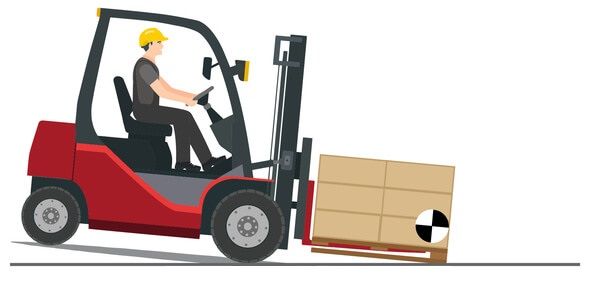Forklift tip-overs are the most common type of forklift accident.
Understanding how and why forklift tip-overs happen is key to preventing them.
That’s why we put this guide together.
In it, you’ll discover everything you need to know about forklift tip-overs, including:
- Why forklifts tip over
- Types of forklift tip-overs
- Principles of forklift stability
- How to prevent forklift tip-overs
- What to do during a forklift tip-over
We’ll also answer some frequently asked questions about forklift tip-overs.
Let’s dive in!
What Is a Forklift Tip-Over?
A tip-over is when a forklift becomes unstable and rolls over on its side, backward, or forwards.
Forklifts are engineered to safely lift heavy loads. To do so, they must maintain a balance between their own weight and the weight of the loads they carry. When an imbalance is introduced, a forklift rollover can happen in seconds – possibly with disastrous consequences.
Why Don’t Forklifts Normally Tip Over?
How is it that forklifts don’t just tip over under normal operations?
Two key concepts best explain this:
- Center of gravity
- Stability triangle
Let’s talk about each in a bit more detail.
Center of Gravity
Every object has a center of gravity. It’s the point in the object where the object’s weight is evenly distributed. For example, a human being’s center of gravity is somewhere around the stomach. It’s the balance point.
It’s the same in a forklift. An unloaded forklift’s center of gravity is usually below the operator’s seat (for a sit-down counterbalance forklift).
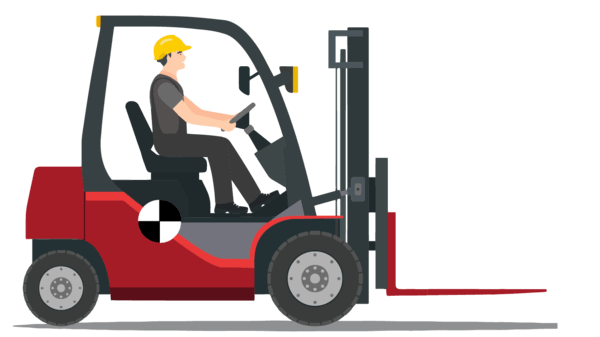
The forklift’s center of gravity can be in different spots, depending on the forklift’s type or design.
Forklift Stability Triangle
What is the forklift stability triangle?
The stability triangle is an imaginary 3D pyramid between the center of the forklift’s rear axle and both wheels of the front axle. The front wheels of a lift truck serve as the fulcrum. Put another way, the pivot point on a counterbalance truck is the axle of the front wheels.
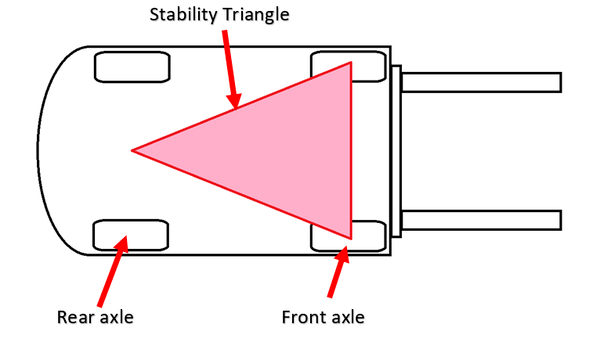
When unloaded, the center of gravity of the forklift is within the confines of the stability triangle.
So long as that’s the case, the lift truck should be stable and unlikely to tip. But as the forklift is loaded, the center of gravity moves towards the perimeter of the pyramid.
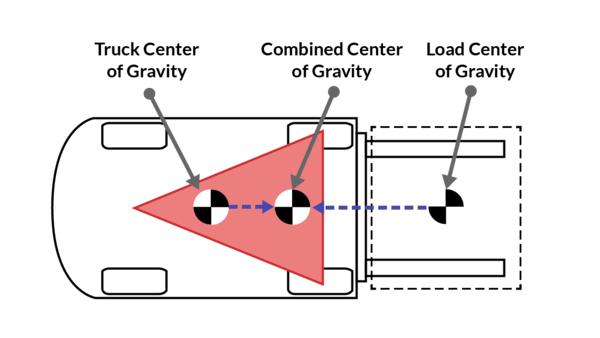
If it moves completely outside the triangle, the forklift will be unstable and liable to tip. Likewise, when lifting a load, the center of gravity also shifts upward.
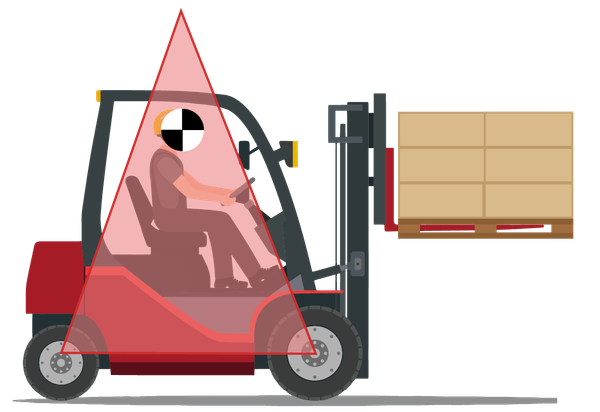
And since a pyramid narrows as you move vertically, the center of gravity loses room to stay within the stability zone. Therefore, it’s more likely to tip over.
Forklift Tip-Over Statistics to Illustrate the Problem
There are approximately 1 million active forklifts in the United States and North America.
It’s estimated that 11% of all forklifts in the U.S. are involved in an accident each year.
While organizations like OSHA regulate working conditions to improve safety, accidents still happen due to various reasons like distracted operators, improper training, or malfunctioning equipment.
Here are some forklift tip-over statistics:
- Forklift tip-overs account for the largest percentage of forklift accidents at 42%.
- Approximately 24% of all industrial truck accidents involve an overturning or tipping forklift.
- Over 25% of all fatal forklift tip-over accidents involve the victim being crushed between the forklift vehicle and a surface.
9 Forklift Tip-Over Causes
What causes forklift tip-over accidents?
Here are some examples of forklift tip-over example situations:
Improper Load Handling and Overloading
Incorrectly handling loads is a key cause of forklift tip-overs. Overloading the forklift or carrying a load beyond the recommended load ratings can make the forklift imbalanced and unstable. Also, improperly positioned loads can shift the center of gravity and destabilize the forklift.
Accelerating or Braking Too Quickly
Slamming on the accelerator or brakes can shift the forklift’s center of gravity outside the stability triangle. This can result in instability and increase the risk of tipping over. Instead, start smoothly and brake gradually until coming to a soft stop.
Excessive Speed
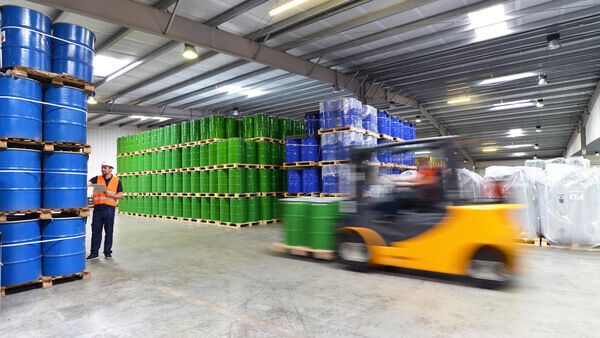
Operating at high forklift speeds increases the risk of tip-overs due to possible loss of stability, sudden changes in direction, or abrupt stops. Forklift operators are advised to drive at a safe and controlled speed, particularly when carrying loads to prevent any occurrence of having a forklift flipped over.
Turning Too Quickly
Weight shifts from turning too sharply at high speeds can also cause lateral forklift tip-overs. The centrifugal force generated during a fast turn can shift the forklift’s center of gravity, leading to instability.
Forklift operators should make gradual turns and avoid sharp, sudden maneuvers. Abrupt turns are prone to accidents and nearly 11% of all fatal forklift accidents involve being crushed between 2 forklift vehicles.
Operating on a Slope
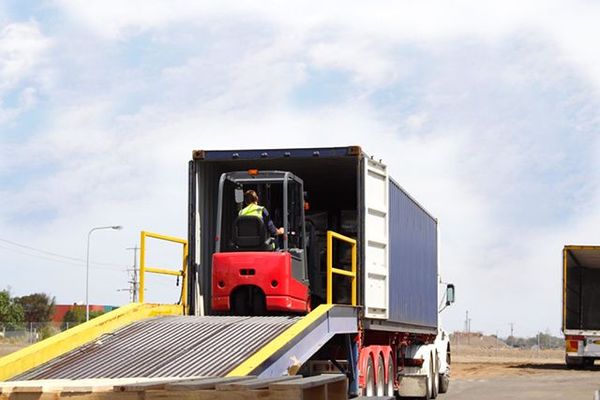
Operating forklifts on slopes increases the risk of tip-overs. This is because the center of gravity can easily shift outside the stability zone when the chassis is tilted at an angle.
As such, forklift operators must be extremely careful when operating on inclines. This includes never lifting or lowering the load on a slope. It also means never turning on an incline. Instead, ascend or descend to level ground and then turn around.
Carrying a Load With the Forklift Mast Tilting Forward
A forklift mast tilting too far forward can make a forklift unstable and result in a forward tip-over. This can occur when the forklift is driven down a ramp or slope. This is why forklift operators are advised to drive forklifts down a ramp backward to avoid a tip-over accident.
In fact, nearly 8% of all forklift accident fatalities occur when the victim is struck by falling material or load. Always adhere to the forklift-rated weight located on the forklift data plate.
Inadequate Forklift Operator Training

Insufficient forklift operator training is a common cause of forklift accidents, including tip-overs. Lack of knowledge about load capacity limits, safe operating practices, and proper load handling techniques can lead to forklift instability and tip-overs.
OSHA reports that approximately 25% of all forklift accidents result from insufficient driver training. Fortunately, many organizations offer high-quality, OSHA-compliant forklift operator training.
Operating on Compromised Surfaces
Uneven or rough surfaces can compromise forklift stability. Bumps, potholes, debris, or slippery surfaces can affect traction and increase the risk of tip-overs. Any work surfaces where the forklift will be operating should be kept free of debris and clutter. Operators should be aware of any compromises in the surfaces they’re operating on and take steps to avoid them.
Inadequate Forklift Maintenance
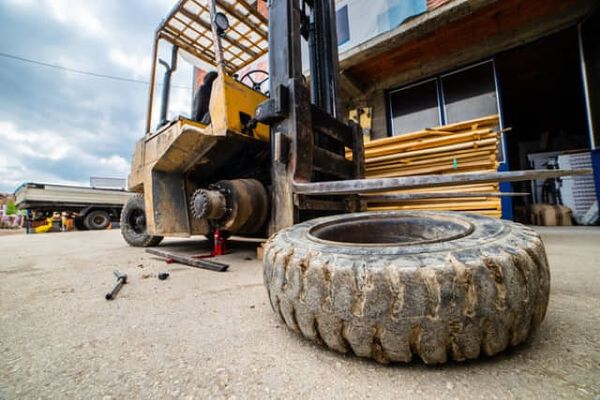
Poorly maintained forklifts can contribute to tip-overs. This can be due to issues with parts like brakes, tires, steering, or hydraulic systems that can affect the forklift’s stability and increase the risk of accidents. Regular maintenance and inspections are crucial to identify and address any potential issues promptly.
The 2 Types of Forklift Tip-Overs
Forklift tip-overs can occur in 2 ways:
- Longitudinal tip-overs
- Lateral tip-overs
Let’s discuss each in more detail.
Longitudinal Forklift Tip-Overs
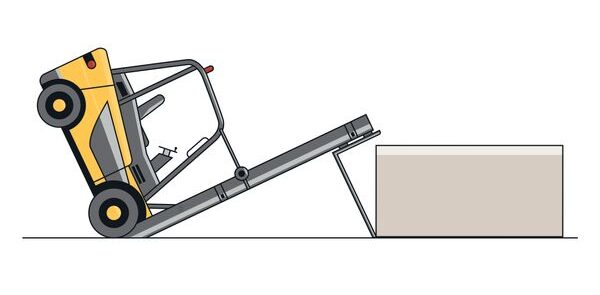
Longitudinal tip-overs occur when a forklift rolls forward or backward.
A longitudinal forklift tip-over is typically caused by:
- Overloading.
- Improper load positioning on slopes.
- Carrying a load with the mast tilted forward.
- Abrupt acceleration or braking, especially when carrying heavy loads.
Proper load distribution, smooth acceleration/deceleration, and maintaining a safe distance from obstacles are essential to prevent forklifts from tipping over forward or backward.
Lateral Forklift Tip-Overs
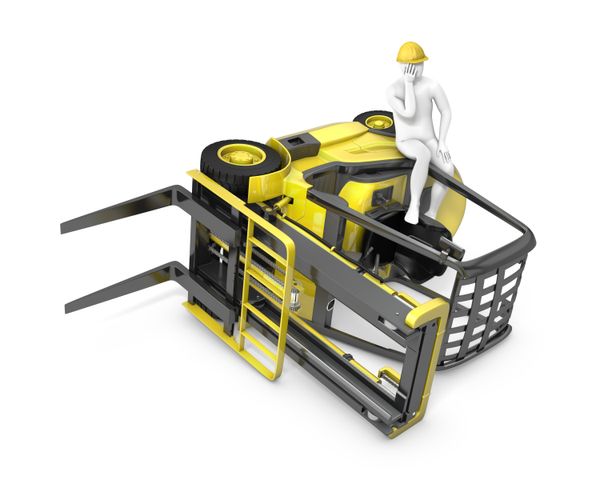
Lateral tip-overs happen when a forklift rolls over sideways.
Often, lateral tip-over forklift occurs when under the following circumstances:
- Turning too abruptly.
- Turning at high speeds.
- Carrying an unbalanced load.
- Traveling on uneven surfaces.
- Encountering obstacles that cause the forklift to become unstable.
It is crucial to maintain proper load positioning and drive at controlled speeds to minimize the risk of lateral tip-overs.
How to Avoid Forklift Tip-Overs: 9 Simple Tips
It’s critical to take measures to prevent forklifts from tipping over.
To avoid forklift tips, it helps to know what to do before and when behind the wheel.
Here are ways to avoid forklift tip-overs:
1. Provide Quality Forklift Operator Training
First things first. Avoiding forklift tip-overs or other accidents requires that all forklift operators undergo proper training before operating a forklift. They should know how to operate the machinery safely and confidently.
This includes forklift operator training on safe operating practices, load capacity limits, stability principles, and recognizing potential hazards.
2. Inspect Before Every Shift

One of the risks of forklift tip-overs is a lack of inspection of the forklift or the operation areas. Conducting pre-operational inspections is not only required by OSHA. It also helps ensure the forklift is in good working condition and the operating area supports safe operation.
Inspect the brakes, tires, steering, hydraulics, and other critical components. Remove debris or obstacles that can cause forklift tip-overs. Ensure proper workplace or warehouse organization before operations.
3. Properly Load the Forklift
Load capacity awareness is important to avoid forklift tip-overs. Forklift operators should position and balance loads carefully. They must also ensure to never exceed the rated weight capacity. Operators should never exceed the maximum load capacity specified by the manufacturer.
4. Distribute the Load Evenly
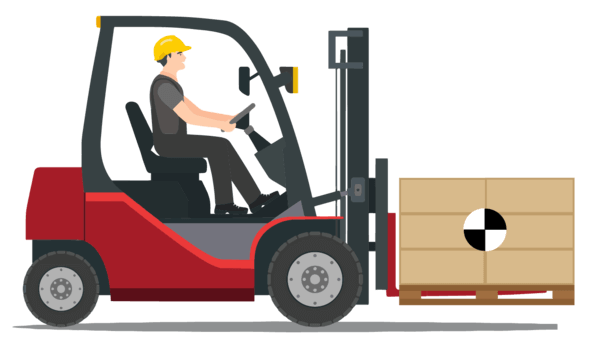
Balancing the load and positioning it properly on the forks is important for maintaining forklift stability. Loads should be centered and positioned low to the ground and travel with the forklift as low to the ground as possible. About 6 to 8 inches is the rule of thumb.
Keeping the load low helps keep the center of gravity within the stability triangle. Also, avoid placing loads too high or too far forward. This can shift the center of gravity and increase the forklift’s risk of tip-overs.
5. Don’t Speed
Forklifts require a slow and controlled operation. That means following speed limits and driving cautiously – especially when carrying a load. So, avoid excessive acceleration, abrupt stops, and sharp turns. Smooth and gradual movements help maintain stability. Also, reduce speed when encountering uneven surfaces, ramps, or obstacles.
6. Take Turns Slowly
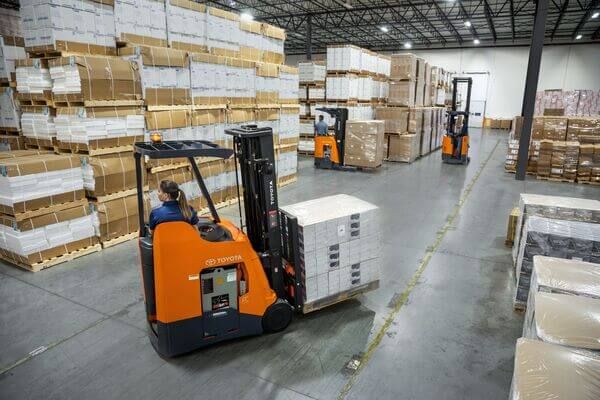
Forklifts are susceptible to tipping over when they are turning, especially abrupt turns. Avoid turns at high speed to prevent forklift tip-overs. Also, never turn a forklift sideways on a slope or incline.
7. Brake Cautiously
If you brake too quickly, the forward motion or momentum of the lift truck can continue and cause the center of gravity to go outside the stability triangle and tip the forklift. Instead, look for things in the way so you can anticipate them, brake gradually, and come to a soft stop.
8. Regularly Maintain Forklifts
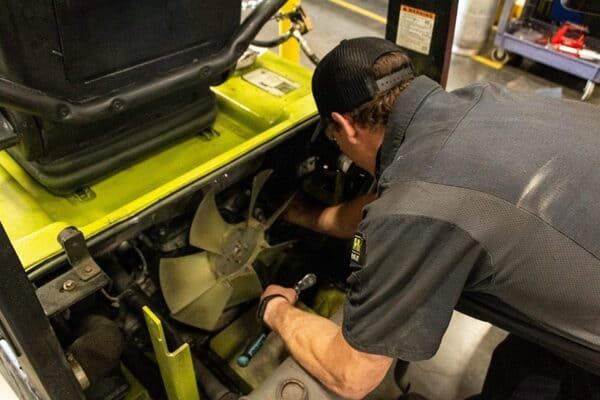
Regular forklift maintenance includes servicing, repairs, inspections, and maintenance to ensure that forklifts are in optimal condition. Maintenance should be performed according to the manufacturer’s recommendations. A maintenance plan can help identify issues before they balloon into bigger problems.
9. Adhere to General Safety Guidelines
Some of the forklift and warehouse safety guidelines forklift operators should observe to prevent tip-overs include:
- Slow down when approaching corners and blind spots.
- Wear a seatbelt at all times.
- Be mindful of your surroundings and ensure the driving surface is clear of debris.
- Keep clear visibility. If a load is too large to see in front of the forklift, the operator should drive backward.
- Approach docks very carefully. For instance, consider if you have water or other moisture on the surface of the ground and a forklift with smooth, cushion tires.
- Route pedestrian traffic away from forklift traffic.
- Deploy safety warnings, cones, signs, etc. as required.
- Enforce traffic rules and designated traffic lanes within the workplace.
What to Do During a Forklift Tip-Over
Note: Every forklift user must understand the specific safety recommendations for the lift truck they operate. These can be found in the operator’s manual. The information below should not be considered a substitute.
What should you do if your forklift starts to tip over?
If a forklift is flipped over, it’s critical to follow specific steps to minimize the risk of injury and forklift tip-over damage.
What you do mostly depends on the particular type of forklift, because it’s a different procedure.
Stand-Up Forklift Tip-Over Procedure
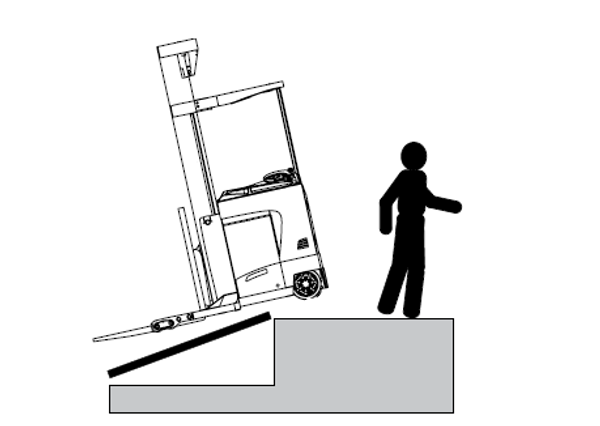
Stand-up forklifts include reach trucks and stand-up counterbalance trucks.
For these lift truck types, the procedure is fairly simple: simply step off the back and get clear of the lift truck.
Sit-Down Forklift Tip-Over Procedure
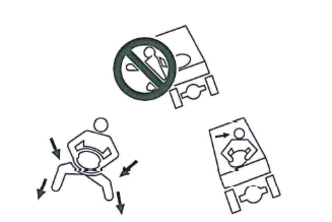
If you’re driving a sit-down counterbalance forklift and it starts to tip sideways, the procedure is different from stand-up forklifts.
If a tip-over occurs, the general procedure is as follows:
1. Stay calm
If your forklift starts to tip over, remain calm and avoid panicking. Keeping a clear mind will enable you to make rational decisions and take appropriate action.
2. Hold onto the steering wheel
Firmly grip the steering wheel with both hands. Hold on tightly to help you maintain control and stability of the forklift.
3. Brace yourself for impact
Use your feet to brace against the floor or the sides of the forklift. This helps you stay balanced and mitigate the impact of the tip-over.
4. Lean in the opposite direction
As the forklift starts to tip, lean in the opposite direction of the tilt. For example, if the forklift is tipping to the right, lean to the left. This will help reduce the chances of being thrown off or crushed.
5. Shield your head
Protect your head with your arms. Try to avoid hazards like the overhead guard or falling objects.
6. Wait for the forklift to come to a stop
Allow the forklift to come to a complete stop before attempting to exit. Moving too early can increase the risk of injury.
7. Call for assistance
Once the forklift tips and lands, call for assistance if you’re able, and don’t try to move out yourself. Let people help you to reduce the chances of injury.
8. Exit the forklift safely if you can
Once the forklift has stabilized and come to a stop, carefully and slowly exit the forklift if you can.
9. Report the incident
If the forklift tips over and you’re OK, report the accident to your supervisor. Then follow your company’s protocols for reporting accidents for documentation and investigation of the incident.
Other employees attending the forklift tip-over scene should help you (the operator) seek immediate medical attention. This should also be done for anyone else injured or with impact.
Common Forklift Tip-Over Questions
Do Forklifts Tip Easily?
Many people would probably be surprised by how quickly and easily a forklift can turn over. Forklifts are very large, heavy objects. And they’re designed with many safety measures to make them as safe as possible. But when proper safety measures are not followed, a forklift can go over on its side in the blink of an eye.
Can a Forklift Tip-Over Without a Load?
A forklift can tip over even if it does not have a load. This is especially a risk if a forklift operator takes a turn too quickly. It can also occur if the operator is driving on an uneven surface. This is another reason why it’s critical to always keep your forklift seat belt on at all times.
Can a Forklift Tip-Over Backward?
A forklift can tip over backward, called longitudinal tip-over. This is often more common when an operator backs off of a loading dock or something related. But it can happen anywhere else if the forklift isn’t handled properly.
How Can a Forklift Tip-Over Sideways?
Sideway (also called “lateral”) tip-overs occur when the center of gravity shifts too far to the side (left or right) of the stability zone. It can happen when the forklift is going around too quickly or if the operator turns on a ramp, which is a big no-no on a forklift.
What Will Make the Forklift Tip-Over Forwards?
Loading a forklift with too much weight, operating with the mast tilted too far forward, and driving up an incline the wrong way are a few causes of forklifts tipping over.
Can an Order Picker Tip-Over?
An order picker can tip over just like a forklift. Order pickers can go anywhere from 10 to 30 feet up in the air. At those heights, there’s not much to prevent an operator from hitting the ground if it tips over. That’s why order picker operators must be careful with their speed, turning, and loading to minimize the risk of it turning over.
What Would Cause a Forklift to Tip Over?
Excessive speed, overloading, turning too quickly, turning at high speed, and going off of a dock plate can cause a forklift to tip over. Turning sharply on slopes, operating on uneven surfaces, braking too quickly, and inadequate training or maintenance can also cause a forklift to tip over.
Is a Forklift More Likely to Tip-Over with or Without a Load?
An unloaded forklift is less stable than a loaded forklift. Here’s why:
Without a load present, a lift truck’s center of gravity is naturally within the forklift stability triangle. But the forklift stability is at risk because the center of gravity can shift easily.
The more weight that is added to the forklift, though, the more the weight will shift toward the front axle. But, add too much weight and you risk a tip-over because of an increased easy shift of the stability triangle and center of gravity.
Do the Chances of a Forklift Tipping Increase If You Tip a Load Forward?
Tilting the mast forward on a forklift can introduce instability and risk of forklift tip-over forward because the stability triangle moves farther forward. Thus, you have to be very careful with any mast movements. A very small mast movement, when the mast is fully extended, can translate to a very large movement and cause a forklift tip-over.
When Should an Operator Raise or Lower a Load?
Operators should not raise or lower the forks unless the forklift is stopped. A forklift is less stable with a raised load because it moves its stability triangle upward and forward. Also, be sure to check the overhead clearance before raising the load. Elevated loads can obstruct vision.
What Happens to the Center of Gravity When You Lift a Heavy Load Above the Forklift?
When unloaded, a forklift is balanced so that its center of gravity stays within the stability triangle. When lifting a load, the center of gravity shifts toward its fulcrum point: the front axle. It also moves upward, toward the peak of the triangle.
What Will Happen If the Combined Center of Gravity Moves Outside the Stability Triangle?
If the combined center of gravity moves outside the stability triangle, the forklift becomes destabilized and may tip over. The combined center of gravity refers to the sum of both the lift truck’s center of gravity and the load’s center of gravity.
What determines the stability of the forklift as a whole is where the combined center of gravity lies. If it’s within the stability triangle, the lift truck will be stable. But if it shifts outside the stability triangle, the forklift can tip over.
What Is the Center of Gravity on a Forklift?
The center of gravity is the point at which the mass of the forklift is most evenly-centered. On a sit-down counterbalance forklift, the center of gravity is typically under the forklift operator’s seat.
What Is the Fulcrum Point on a Forklift?
The fulcrum point of a forklift is the front axle. This is where the counterweight and the load (including the forklift’s body) find balance.
What Should You Do to Avoid Tipping Over in a Forklift?
Be mindful of these safety best practices to avoid tipping over a forklift:
- Don’t overload the forklift.
- Keep your speed down.
- Be careful when tilting the mast.
- Don’t brake too suddenly.
- Be mindful of docks and drop-offs.
- Keep the forklift maintained.
- Don’t take corners too quickly and don’t take sharp corners.
- Don’t operate the forklift on risky grounds with debris or obstacles.
- Only properly trained operators should operate the forklift.
How Can I Improve Forklift Stability?
To improve your forklift’s stability, your first lines of defense are proper operator training and effective supervision. You also need to keep the load within the forklift truck’s load capacity and avoid overloading the lift truck. Ensure the load is distributed evenly. Also, the load should be up against the load backrest to bolster its stability.
You can also look at particular lift truck technologies available. For example, take Toyota’s System of Active Stability. This is basically a computerized system that monitors different forces acting on the forklift and then mechanically manipulates the steering axle to neutralize instability.
What Should You Do If a Forklift Tips Over?
How you react if a forklift tips over depends on the type of machine you’re operating.
If your sit-down counterbalance starts to tip, put your feet flat on the floor, grip the steering wheel with both hands, brace yourself, and lean away from the point of impact.
If your stand-up forklift tips over, step backward, out of the operator compartment, and free from the forklift.
Other things you can do include:
- Keep your forklift seat belt fastened.
- Protect your head using our arms.
- Wait for the forklift to come to a stop before attempting to exit.
- Call for assistance if you’re able.
- Exit the forklift safely only if you can.
Conclusion
There you have it: Forklift tip-over stats, causes, prevention, and procedures.
![Forklift Tip-Overs [Stats, Causes, Prevention, and Procedures]](https://www.conger.com/wp-content/uploads/2023/06/Untitled-design-1.png)

